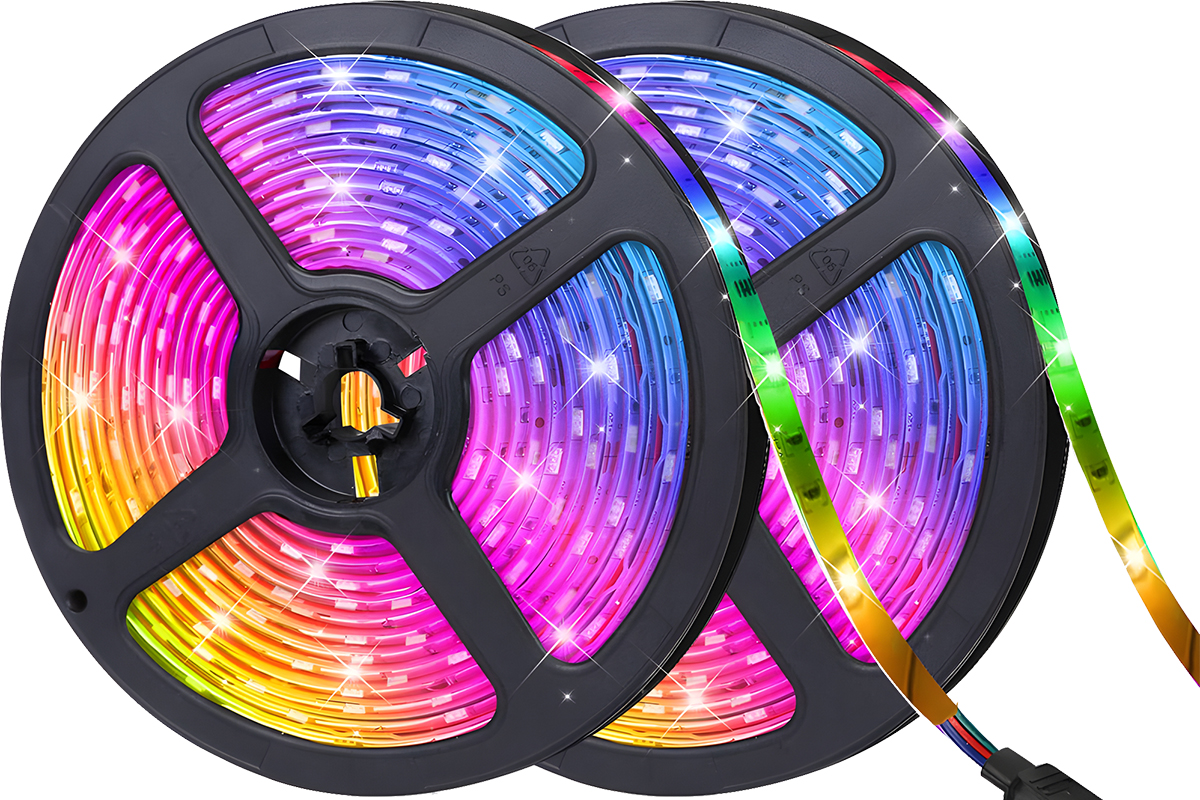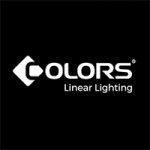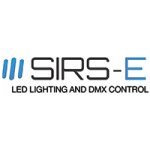Table of Contents Hide

Color changing LED strip lights are flexible or rigid linear LED assemblies that consists of a flexible circuit board embedded with light-emitting diodes (LEDs) capable of emitting various colors. These strips are designed to provide a versatile and visually appealing lighting solution that allows users to create dynamic and customizable lighting environments. The combination of LEDs in different color channels, control circuitry, and external controllers enables a wide range of color options and lighting effects.
How do color changing LED strips work
Color-changing LED strips often use red, green, and blue LEDs (RGB) or may include additional colors such as white (RGBW) or amber (RGBA). Adjusting the intensity of each channel changes the overall spectral power distribution (SPD) and, consequently, the perceived color. A color changing LED strip includes a control circuit that regulates the intensity of each color channel. This circuit is responsible for adjusting the brightness of individual LEDs to create specific colors. To change the colors and control the LED strip, an external controller is used. This controller can be a physical device, a remote control, or even a smartphone app. It controls the intensities of the LEDs using different dimming technologies such as PWM (Pulse-Width Modulation) and constant current reduction (CCR).LED Dimming
PWM dimming is a technique that modulates the on-off time of an electrical signal to control the average power delivered to a device. The ratio of the on-time to the total period (duty cycle) determines the brightness of the LED. A higher duty cycle results in more light output, while a lower duty cycle reduces brightness. In color mixing applications, PWM is often used to independently control the intensity of red, green, and blue LEDs (or other color channels) in RGB LED setups. By adjusting the duty cycle of each color channel, a wide spectrum of colors can be produced. PWM is an efficient method for dimming LEDs, providing precise control over brightness and color.CCR dimming is a technique that adjusts the current flowing through the LEDs to control brightness. Instead of modulating the on-off time of the LEDs, the current supplied to the LEDs is varied. By reducing the current, the brightness of the LED is decreased, and vice versa. CCR maintains a constant current to the LED, adjusting the overall luminosity. Similar to PWM, CCR can be used for color mixing in multi-color LED setups. By independently adjusting the current to each color channel, different colors can be achieved. CCR is often favored for its simplicity and compatibility with certain types of LEDs. It can provide smooth dimming without the potential for flickering that can be associated with PWM.
PWM is commonly used in digital control systems, making it suitable for applications where precise digital control is essential, such as in smart lighting systems. CCR is often considered more analog in nature, offering smooth transitions in brightness. It may be preferred in situations where simplicity and analog dimming are priorities. The choice between PWM and CCR depends on the specific requirements of the LED lighting application, the type of LEDs used, and the desired control characteristics. Some LED drivers and controllers use a combination of PWM and CCR techniques to optimize performance and address specific requirements in color mixing applications.
How are color changing LED strip lights controlled
Color-changing LED strip lights are controlled through various methods, and the communication protocols used depend on the specific type of LED strip and the control system in place. When choosing color-changing LED strips, it's essential to consider the desired level of control and integration. Some LED strips are designed for simple, standalone applications with manual controls, while others are part of more sophisticated systems that allow for remote control, automation, and integration into smart home environments.Remote controls and physical controllers
Many color-changing LED strips come with a remote control. The remote allows users to manually adjust colors, brightness, and sometimes other effects. The communication between the remote and the LED controller is typically achieved through infrared (IR) signals.Smartphone apps
Some color changing LED strips are designed to be controlled via Bluetooth. Users can download a dedicated app on their smartphones to control the LED strip. This method allows for more advanced features and programmability. Smart LED strips with Wi-Fi capability can be controlled using a smartphone app through a Wi-Fi connection. This enables remote control and integration with smart home systems.dmx-digital-multiplex" data-toc="1" >DMX (digital multiplex)
In professional settings, color-changing LED strips may be integrated into larger lighting systems using DMX controllers. DMX is a standard protocol for controlling stage lighting and effects. DMX allows for precise control over multiple channels, enabling complex lighting sequences. LED strips compatible with DMX often require a DMX decoder, which interprets the DMX signal and controls the LED strip accordingly.Wireless RF (radio frequency)
Color changing LED strip lights can be controlled wirelessly using RF controllers. These controllers communicate with the LED strip through radio frequency signals, offering greater range compared to infrared.DALI (Digital Addressable Lighting Interface)
In commercial and industrial settings, DALI is a protocol used for lighting control. DALI-compatible LED strips can be integrated into DALI systems for centralized control and automation.Voice control
Some color changing LED strips can be integrated with voice-activated assistants like Amazon Alexa or Google Assistant. This allows users to control the lights using voice commands.Color Configuration
The basic color configuration of a color changing LED strip uses three primary colors (Red, Green, Blue). Each LED package or color mixing unit is capable of emitting red, green, and blue light. The combination of these primary colors allows for a wide range of colors to be produced. RGBW adds white to the mix. The addition of a white LED allows for better color accuracy and the creation of pure white light. This can be particularly useful in applications where true white illumination is required. RGBA adds amber to the mix. The inclusion of amber LEDs enhances the color palette and allows for warmer tones in the light spectrum. This can be beneficial for creating a broader range of warm and natural lighting effects. RGBWA LED strip lights combines RGB color channels with both warm white and amber LEDs for a diverse color palette. In some cases, color changing LED strip lights may include RGB color channels along with both warm white and cool white LEDs for versatile color temperatures (RGBW+WW/CW).Addressable LED strips vs. non-addressable LED strips
Color changing LED strip lights, like other LED lighting systems, require a power supply to regulate electrical power for the LEDs.Individually addressable LED strips, such as those using WS2812 or SK6812 chips, require a specific type of LED driver to control the individual LEDs. The LED driver in individually addressable LED strips is typically an integrated circuit (IC) that includes both a microcontroller and a driver. This IC is responsible for handling the communication protocol and power requirements of addressable LEDs. Digital communication typically occurs through a one-wire digital protocol, where data is sent to each LED in sequence. This data input includes information about the desired color and brightness for each LED. This level of control allows each LED to display a different color independently of the others. This ability makes individually addressable LED strips for lighting applications where dynamic and programmable lighting effects are desired.
In non-addressable (analog) LED strip lights, all LEDs are controlled as a group rather than individually. The color and intensity are the same for all LEDs on the same circuit at any given time. Non-addressable LED strips typically do not require a microcontroller for basic operation. Analog LED strips are often more cost-effective than addressable counterparts. They are generally simpler to control and can often be operated with basic dimmer switches, controllers, or simple voltage adjustments. They are made for applications where uniform lighting across the entire strip light is sufficient, such as accent lighting, cove lighting, or under-cabinet lighting.
Applications
Color changing LED strip lights find applications in a variety of settings where dynamic and customizable lighting effects are desired. They are versatile and can be adapted to numerous creative and practical applications. Their flexibility, ease of installation, and programmable nature make them a popular choice for individuals and businesses seeking dynamic and customizable lighting solutions.- Color changing LED strip lights can be installed under cabinets, along baseboards, or behind furniture to add a decorative and customizable touch to living spaces.
- Installed in hotel guest rooms, residential bedrooms and living rooms, color changing LED strips allow people to personalize the lighting to suit their preferences and moods. They can be installed behind TVs or along entertainment units to create an immersive experience.
- Color changing LED strips can be used to dynamically highlight architectural features such as coves, recesses, or other design elements.
- These lights are a popular choice for events and parties. They can be easily installed and controlled to match the theme or create a vibrant atmosphere during events or special occasions.
- Artists and designers use color changing LED strips to create dynamic and interactive art installations.
- They're often used to add accent lighting to the interior of vehicles for a customized look.
- From customizing furniture to building interactive installations, do-it-yourself (DIY) enthusiasts use these strips to add a personalized touch.






































